We need your consent to use the individual data so that you can see information about your interests, among other things. Click "OK" to give your consent.
ASTM D3654/D3654M-06(2011)
Standard Test Methods for Shear Adhesion of Pressure-Sensitive Tapes
STANDARD published on 1.8.2011
The information about the standard:
Designation standards: ASTM D3654/D3654M-06(2011)
Note: WITHDRAWN
Publication date standards: 1.8.2011
SKU: NS-24349
The number of pages: 6
Approximate weight : 18 g (0.04 lbs)
Country: American technical standard
Category: Technical standards ASTM
The category - similar standards:
Annotation of standard text ASTM D3654/D3654M-06(2011) :
Keywords:
filament-reinforced tape, pressure-sensitive tape, shear adhesion: Adhesion--pressure-sensitive tapes, Displacement, Fiberboard containers, Loading tests--pressure-sensitive tapes, Packing/packaging materials/systems (pressure-sensitive tape), Pressure-sensitive tapes, Steel surfaces, Stress--tapes, Surface analysis--pressure-sensitive tapes, ICS Number Code 55.040 (Packaging materials and accessories)
Additional information
| Significance and Use | ||||||||||||||||
|
Procedure A measures the ability of a pressure-sensitive tape to adhere to a standard steel panel under constant stress. This may or may not relate to the ability of the tape to adhere to other surfaces. Procedures B, C, and D may be used to determine the shear adhesion of the tapes generally used to close fiberboard boxes in packaging applications. Procedure D measures the shear adhesion of a pressure-sensitive tape to a nonstandard fiberboard, liner board, corrugated board, or other surfaces which is agreed upon for testing. This may be used to compare the shear adhesion of a tape to a particular fiberboard surface or to compare the shear adhesion of a tape to a variety of fiberboard surfaces. The surfaces of similar fiberboards may exhibit considerable variation between mills, between batches from one mill, and within batches. Take care in the choice of samples and when comparing results between fiberboard surfaces which may not be exactly the same. The precision of tests conducted on nonstandard surfaces may be different than that described in Section 13. Procedures E, F, and G may be used to determine the ability of a filament reinforced tape to hold when placed under constant stress. Procedure H may be used to compare the shear adhesion of tape applied to a standard steel surface and tested at an elevated temperature. The use of an elevated temperature during test tends to reduce the duration of the test. |
||||||||||||||||
| 1. Scope | ||||||||||||||||
|
1.1 This test method covers procedures for determining the ability of pressure-sensitive tapes and labels to remain adhered under constant load applied parallel to the surface of the tape and substrate. 1.1.1 Procedure A measures the shear adhesion when applied to a vertical standard steel panel. 1.1.2 Procedure B measures the shear adhesion when applied to vertical panel covered with NIST SRM 1810A standard fiberboard. 1.1.3 Procedure C measures the shear adhesion when applied to a vertical panel covered with a fiberboard as defined by Comite Europeen de Normalisation (CEN). 1.1.4 Procedure D measures shear adhesion when applied to a vertical panel covered with a fiberboard agreed upon by the buyer and seller. 1.1.5 Procedure E measures shear adhesion of filament reinforced tape when applied to a horizontal standard steel panel. 1.1.6 Procedure F measures shear adhesion of a filament reinforced tape when applied to a horizontal panel covered with NIST SRM 1810A standard fiberboard. 1.1.7 Procedure G measures the shear adhesion of a filament reinforced tape when applied to a horizontal panel covered with a standard fiberboard defined by CEN. 1.1.8 Procedure H measures the shear adhesion the same as Procedure A except the test is conducted at an elevated temperature and after a 10-min dwell time at the elevated temperature. 1.2 These procedures provide a means of assessing the uniformity of the adhesive of a given type of pressure-sensitive tape, usually tapes used for packaging applications. The assessment may be within a roll of tape, between rolls or production lots. 1.2.1 Variations in the tape backing and adhesive affect the response; therefore, these procedures cannot be used to pinpoint the specific cause(s) of nonuniformity. 1.2.2 This test method is intended to replace AFERA 4012, CEN 1943, and PSTC (see 7.2). 1.3 The values stated in either SI units or inch-pound units are to be regarded separately as standard. The values stated in each system are not be exact equivalents; therefore, each system shall be used independently of the other. Combining values from the two systems will result in non-conformance with the standard. 1.4 This standard does not purport to address all of the safety concerns, if any, associated with its use. It is the responsibility of the user of this standard to establish appropriate safety and health practices and determine the applicability of regulatory limitations prior to use. |
||||||||||||||||
| 2. Referenced Documents | ||||||||||||||||
|
Similar standards:
Historical
1.4.2008
Historical
1.11.2009
Historical
1.8.2011
Historical
1.8.2010
Historical
1.3.2009
Historical
1.5.2014
We recommend:
Technical standards updating
Do you want to make sure you use only the valid technical standards?
We can offer you a solution which will provide you a monthly overview concerning the updating of standards which you use.
Would you like to know more? Look at this page.


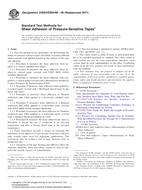
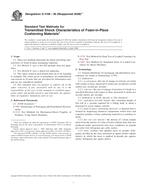 ASTM D4168-95(2008)e..
ASTM D4168-95(2008)e..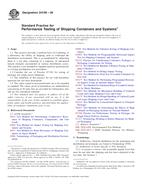 ASTM D4169-09
ASTM D4169-09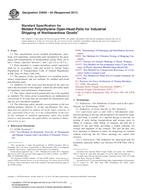 ASTM D4504-94(2011)..
ASTM D4504-94(2011)..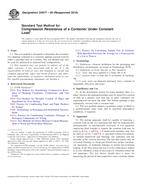 ASTM D4577-05(2010)..
ASTM D4577-05(2010)..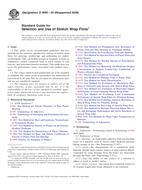 ASTM D4649-03(2009)..
ASTM D4649-03(2009).. ASTM D4675-14a
ASTM D4675-14a
 Cookies
Cookies
